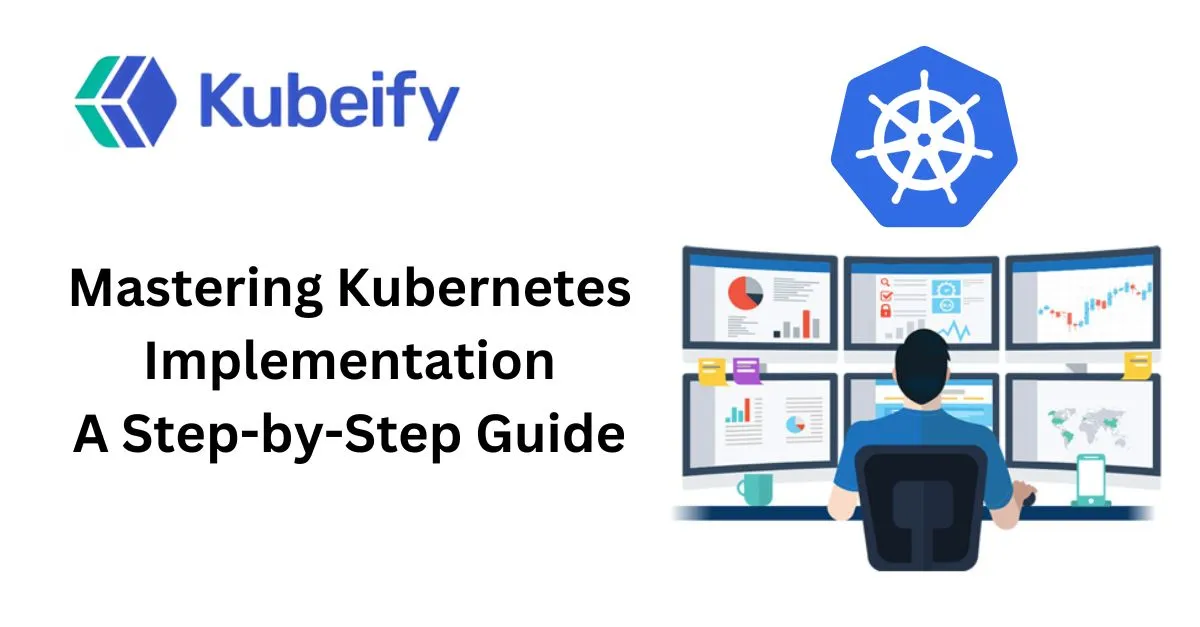AI Cloud
- Cloud Native Product Development
- Cloud Native FaaS
- Monolith to Microservices
- DevSecOps as a Service
- Kubernetes Zero Downtime

Kubernetes has become the go-to solution for managing containerized applications in production at scale. With its flexibility and scalability, Kubernetes allows organizations to deploy, scale, and manage applications with ease. However, implementing Kubernetes for the first time can seem like a daunting task. In this step-by-step guide, we’ll walk you through the key stages of Kubernetes implementation, ensuring a smooth and successful deployment!
1. Define Your Kubernetes Objectives
Before diving into the technicalities of setting up Kubernetes, it’s essential to have a clear understanding of why you’re implementing Kubernetes. What are your main goals? What challenges are you trying to solve? Defining your objectives will help guide your decision-making throughout the process.
Key Considerations:
● Scaling Needs: Do you need to scale rapidly or manage high-availability applications?
● Resource Management: Are you looking to optimize costs or better allocate resources?
● Deployment Strategies: Do you want to use a hybrid cloud or multi-cloud environment?
2. Choose Your Kubernetes Deployment Model
Kubernetes can be deployed in several ways depending on your requirements and existing infrastructure. Choosing the right deployment model is crucial for efficient management and scalability.
Deployment Models:
● On-Premises Deployment : If you have existing hardware and want to manage everything in-house.
● Cloud-Native Kubernetes : Managed Kubernetes solutions such as Google Kubernetes Engine (GKE), Azure Kubernetes Service (AKS), or Amazon EKS simplify the process by taking care of the infrastructure.
● Hybrid/Multi-Cloud Deployment : A combination of on-premises and cloud-based clusters for greater flexibility and disaster recovery options. Best Practice: Start with a managed Kubernetes solution if you’re new to Kubernetes to minimize infrastructure complexity and focus on the application.
3. Set Up the Kubernetes Cluster
Once you’ve decided on the deployment model, the next step is to set up your Kubernetes cluster. This involves installing the necessary tools and configuring the cluster’s architecture.
Steps:
● Install Kubernetes Tools: Install essential tools like kubectl (command-line tool), and set up kubeadm (for manual setup), or use the managed service of your cloud provider.
● Set Up Nodes: A Kubernetes cluster consists of a master node (controls the cluster) and worker nodes (run your applications). You’ll need to configure these nodes according to your deployment model.
● Configure Networking: Set up a networking solution (e.g., Calico or Weave) to allow communication between pods and services within the cluster.
Best Practice: If using managed Kubernetes, much of the setup will be automated, but ensure you have the necessary tools for monitoring and management.
4. Configure Storage and Persistent Volumes
In Kubernetes, workloads often require persistent storage. By default, containers are ephemeral, meaning any data stored within a container is lost when it’s terminated. This is where Persistent Volumes (PVs) come in.
Steps:
● Choose Storage Backend: Pick the right storage solution (e.g., AWS EBS, Google Persistent Disk, NFS, etc.) based on your needs for performance and availability.
● Set Up Persistent Volumes: Define PersistentVolumeClaims (PVCs) to manage storage requests by your applications.
Best Practice: Always use StatefulSets for applications that require persistent storage, such as databases, to maintain data consistency.
5. Define and Deploy Applications in Kubernetes
Now that your cluster is up and running, the next step is to deploy your applications. Kubernetes abstracts the underlying hardware and gives you a flexible platform to deploy, scale, and manage containers.
Steps:
● Write Kubernetes Manifests: Create YAML files to define your Pods, Deployments, and Services. This declarative approach allows Kubernetes to maintain your desired application state.
● Use Helm for Simplified Deployment: Helm, the Kubernetes package manager, allows you to define reusable Kubernetes charts for your applications.
● Deploy with kubectl: Run the kubectl apply -f
6. Implement Monitoring and Logging
Monitoring and logging are crucial for understanding how your applications are performing in Kubernetes. You’ll want to keep track of resource usage, pod health, and application logs to troubleshoot and ensure smooth operation.
Steps:
● Install Prometheus and Grafana: Prometheus will collect metrics, while Grafana allows you to visualize them. Together, they provide comprehensive monitoring of your Kubernetes environment.
● Set Up Fluentd or ELK Stack: Use Fluentd or the Elastic Stack (ELK) for logging. These tools aggregate logs from your containers, helping with troubleshooting and auditing.
Best Practice: Ensure that your monitoring and logging tools are integrated from day one to detect issues early and maintain operational health.
7. Set Up Continuous Integration and Continuous Deployment (CI/CD)
One of Kubernetes’ greatest strengths is its ability to support CI/CD pipelines, enabling automated testing, deployment, and scaling of applications.
Steps:
● Choose a CI/CD Tool: Popular tools like Jenkins, GitLab CI, and CircleCI integrate seamlessly with Kubernetes.
● Automate Deployments: Use Helm or Kubernetes kubectl commands within your CI/CD pipelines to deploy updates automatically.
● Use GitOps: For more advanced setups, GitOps with ArgoCD or Flux can automate Kubernetes application deployments directly from version-controlled Git repositories.
Best Practice: Keep your CI/CD pipelines tightly integrated with your Kubernetes workflows to maintain consistent and automated deployments.
8. Implement Security Best Practices
Security is paramount in any Kubernetes deployment, especially in production. With so many moving parts, it’s important to set up a strong security framework to protect your infrastructure and applications.
Steps:
● Use Role-Based Access Control (RBAC): Define user and service account permissions to control access to Kubernetes resources.
● Enable Network Policies: Use network policies to control traffic flow between pods and limit unnecessary exposure.
● Use Secrets Management: Store sensitive information like database passwords and API keys securely using Kubernetes Secrets or tools like Vault.
Best Practice: Regularly audit your cluster using tools like Kube-Bench to ensure compliance with best security practices.
9. Optimize and Scale Kubernetes Cluster
As your application grows, so will your Kubernetes cluster. It’s important to keep optimizing your cluster for performance and cost-efficiency, especially as you scale.
Steps:
● Use Horizontal Pod Autoscaling (HPA): Automatically scale your application pods based on metrics like CPU usage or custom metrics.
● Cluster Autoscaler: Use the Cluster Autoscaler to add or remove nodes in your cluster based on demand.
● Optimize Resource Requests and Limits: Adjust CPU and memory allocations for your pods to prevent over-provisioning and reduce costs.
Best Practice: Use Kubernetes Vertical Pod Autoscaler (VPA) along with HPA to ensure that each pod is right-sized for optimal performance and cost.
10. Ongoing Maintenance and Upgrades
Once your Kubernetes cluster is up and running, ongoing maintenance is key to keeping it healthy and up-to-date. Kubernetes releases frequent updates, and security patches should be applied promptly.
Steps:
● Apply Updates Regularly: Kubernetes and its dependencies receive frequent updates. Stay current with new releases to benefit from bug fixes and security patches.
● Monitor Cluster Health: Continuously monitor the health of your cluster and its resources to identify potential issues before they impact production workloads. Best Practice: Implement a rolling upgrade strategy to ensure minimal downtime when updating Kubernetes versions.
**Conclusion **
Mastering Kubernetes implementation requires careful planning and execution, but with this step-by-step guide, you are now equipped to take your container orchestration to the next level. From defining your objectives to ongoing maintenance, every step plays a crucial role in ensuring that Kubernetes supports your organization’s growth and operational efficiency.
By following these steps, you’ll be able to deploy applications faster, scale effortlessly, and maintain the reliability and security of your Kubernetes environment.
Ready to get started? Let’s deploy and scale your applications with Kubernetes!

Kubeify's team decrease the time it takes to adopt open source technology while enabling consistent application environments across deployments... letting our developers focus on application code while improving speed and quality of our releases.
– Yaron Oren, Founder Maverick.ai (acquired by OutboundWorks)
Let us know what you are working on?
We would help you to build a
fault tolerant, secure and scalable system over kubernetes.
